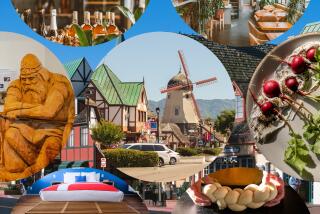The Olympic Spirit
- Share via
One of my fondest restaurant memories from earlier days of dining around Los Angeles is a scene (oft-repeated) at the now-defunct Scandia. I’m settled into one of those tall, broad, dark-red leather wing chairs at a table in the bar, beginning a dinner with friends. Later, we’ll investigate the excellent, reasonably priced wine list and eat good salmon or hearty meat of some kind--but for now our food and drink is something simpler, if also somehow more exotic: We begin, almost inevitably, with the restaurant’s famous assortment of herring, five or six kinds in different preparations; with this comes a basket of various Scandinavian-style breads, mostly dark or medium-dark, some salty and some sweet.
And to drink, there is really only one possibility: Shots of Aalborg Akvavit from Denmark, served in heavy little glasses, poured from a napkin-wrapped bottle frozen in a cylinder of cloudy ice. Strong, straightforward, crystal-clear, flavored with an earthy note of caraway and so cold that it has slowed to an almost syrupy consistency, it is all but irresistible--and it is impossible to imagine any other liquid simultaneously complementing and offsetting the delicious herring so effectively.
More than once since Scandia’s demise, while sitting down in some more gastronomically current local eatery to yet another goat-cheese pizza or rib-eye steak and yet another bottle of Chianti Classico or Central Coast Syrah (much as I enjoy those things), I have thought with some longing of that particular combination of food and drink--a combination now so resolutely untrendy (and difficult to come by, at least in Los Angeles).
More than once, I’ve gone down to my local German deli for herring--not Scandia’s, but not bad--and bought a bottle of Aalborg or some other aquavit. Not often enough, now that I come to think about it--but more than once.
*
What is aquavit, exactly? (The Swedes and Norwegians spell it thus; in Danish, it’s “akvavit.”) The easy answer is that it’s a spirit distilled from grain and/or potatoes, usually in Scandinavia (though some is made in Germany) and usually with flavor added. Caraway is the most common accent, at least in examples of the stuff exported to the U.S., but there are also aquavits infused with elderberry, coriander, dill, sweet myrtle gale, licorice, bog-myrtle, bitter oranges and other citrus fruits, even Madeira wine. (The British writer Giles McDonogh has described one Swedish variety, called Ahus Bitters, as tasting “like the entire contents of the spice box macerated in alcohol.”) The name derives from the Latin term “aqua vitae” or “water of life”--which is what the first distilled spirits were supposedly dubbed by Arnaud de Vilanova, the 16th-Century Spanish physician and scientist who is usually credited with introducing the Arab art of distillation into Europe. (The French term “eau de vie,” which usually refers specifically to clear fruit brandies, means the same thing.) The first aquavit officially made in Scandinavia seems to have been a product of the Royal Danish Distillery, established in 1555 by King Christian III.
The definition of aquavit gets slightly complicated, though, when you try to draw the line between it and other spirits popular in northern climes. The term “schnapps,” for instance, is widely used in Germany, Switzerland and Scandinavia (the Danish say “snaps”) to mean any sort of more-or-less neutral spirits, flavored or otherwise. Aalborg Akvavit, for instance. Then there’s “brannvin,” a term used similarly in Sweden. (Like the Dutch word “brandewijn,” from which we derive the word “brandy,” it means “burnt wine.”) The famous Swedish vodka Absolut, for instance, began life in 1879 as a product called “Absolut Renadt Brannvin”--which might be translated as “absolutely pure schnapps”--said to have been distilled 10 times. However, when the Swedish government’s alcohol monopoly launched Absolut’s descendant as an international brand in 1979, they labeled it vodka. Fair enough, I suppose--but I’m not at all sure that the flavored versions of Absolut, one infused with spicy chiles, the other with “citron” (a mix of citrus essences), mightn’t be described quite accurately as aquavits themselves.
*
Most of the aquavit sold in America today comes from Denmark or Sweden--though there is one prominent Norwegian brand available. The most famous--and most commonly found--is the aforementioned Aalborg, from Denmark. Aalborg is also the name of a city in North Jutland, site of the Danske Spritfabrikker or Danish Spirit Factory, which produces all of that nation’s aquavit. At least a dozen varieties of the spirit are made there. What we know simply as Aalborg is called Taffel or Red Taffel in Denmark. Jubilaeum, another aquavit found on these shores, is also distilled in Aalborg.
The most prominent Swedish brands in the United States are O.P. Anderson and Skane. The Norwegian entry is Linie, which is the smoothest of the lot, aged in old oak sherry barrels and shipped in casks on an ocean voyage across the Equator before bottling. (“Linie” means “line.”) The motion of the ship supposedly helps it age more rapidly and wears off the rough edges. (Certain kinds of sherry were traditionally treated in the same way; anything marked “India,” for instance, has theoretically been shipped from Spain to that country and back.)
Some people like aquavit at room temperature. To me--my Scandia conditioning, I’m sure--the colder it is the better. (I once figured out how to encase a bottle in ice, incidentally: Cut the top off a half-gallon milk carton, place the bottle inside and fill the carton with water. Freeze it, then peel the carton away and shape the remaining ice into a cylinder with hot water.) And, though I have to admit that I’m sipping a bit of very chilly Norwegian Linie by itself right now as I finish this piece late on a rainy evening, I also think that aquavit shows itself best, by far, with food--preferably oily fish of some kind (eel, smoked salmon, herring of course) or various other smorgasbord/ smorrebrod treats. The tableside ritual for drinking aquavit, incidentally--memorably illustrated in a series of photographs starring Swedish actor Max von Sydow in the Time/Life Foods of the World volume on “The Cooking of Scandinavia”--is to engage your drinking partner’s gaze; tip your head (and glass) backward, draining the aquavit in a single swallow; then return your head (and glass) to their original position and look your partner straight in the eye again.
One other way of drinking aquavit is as a spike for coffee. The old way of blending java and schnapps was to place a silver coin in the bottom of an empty coffee cup, pour in enough coffee to obscure the coin, and then add aquavit until you see it again. If Scandia had served breakfast, I’m sure I’d have nostalgic thoughts for this preparation as well.
TASTING NOTES
DENMARK
*
Aalborg Akvavit ($16.50). Pure, clean, delicious--with a pronounced character of caraway. A good introduction to the genre (and a nostalgic favorite for me).
*
Jubilaeum Akvavit ($13.25). An aggressively contemporary package--triangular bottle, kicky wraparound label with contempo graphics--and a strong citrus aroma and flavor (mostly oranges, it seems to me). The books say Jubilaeum is flavored primarily with coriander and dill. If those elements are present here, they are faint--and I wonder if the marketing arm of Dansk Spritfabrikker hasn’t just borrowed the name for an export product aimed, perhaps, at capturing the Absolut Citron drinker.
SWEDEN
O.P. Anderson Aquavit ($13.95). A lovely, subtle aquavit with a complex nose suggesting vanilla and something herbaceous. The color is that of an oaky Chardonnay, and the mildly woody aftertaste almost reminds me of a very light Scotch whisky. Superb.
*
Skane Aquavit ($15.25). The charms of this one are lost on me. Caraway and anise seem to color both the aroma and the flavor, but there just isn’t much to it, and the aftertaste is slightly bitter.
NORWAY
Linie Aquavit ($19.50). Very smooth, the color of fino sherry, with lots of caraway in the nose and a vaguely fruity finish. Not at all unpleasant to sip by itself. (According to the books, each bottle of Linie is supposed to bear the name of the ship on which its lot crossed the Equator and the date on which the deed was done, but I can’t find either piece of information on my bottle, so perhaps this is a refinement that has been lost.)
More to Read
Eat your way across L.A.
Get our weekly Tasting Notes newsletter for reviews, news and more.
You may occasionally receive promotional content from the Los Angeles Times.










